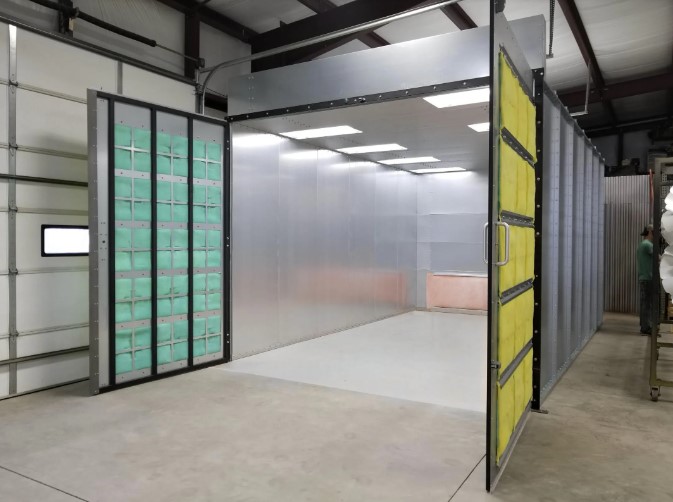Beautiful and Powerful Financial-Planning Software for FIRE
I love beautifully-designed software.
I love powerful/flexible financial software.
It’s been a while since I’ve found an application that’s both, but that’s exactly what I have for you today…
ProjectionLab is the most beautiful financial planning tool I’ve ever seen.
And, it was created specifically for people pursuing FIRE, so it’s also the most-useful planning tool I’ve found for FI!
The indie developer who built it is here today to tell you all about it.
Take it away, Kyle!
Hey everyone, I’m Kyle.
When I finished undergrad back in 2015, I never thought that just 8 years later I would have achieved financial independence by 30… and I was right! I have not 🥲
But I have at least started getting my act together. Thanks in large part to blogs, books, and podcasts like The Mad Fientist, The Simple Path to Wealth, A Random Walk Down Wall Street, Psychology of Money, Financial Freedom, and many other favorites.
During my early years in “the real world,” I rarely thought about money. Sure, I knew a few rules of thumb – save some for retirement, don’t spend an exorbitant amount on rent. But mostly, I would daydream about when I’d have enough PTO for another vacation to go scuba diving and make travel videos.
But what accompanied those daydreams was a gnawing feeling that there should be more to life than the classic American pattern of working until you’re too old to enjoy it.
Does sacrificing the best hours of your best days of your best years to meetings, briefings, and bureaucracy really add up to your best life?
Then I discovered FI community thought leaders like Pete Adeney, J.L. Collins, Vicki Robin, and The Mad Fientist. Their message hit me like a freight train. I knew right away that I needed to take more active control of my financial future. And that if I did, someday I might eventually have the freedom to be my best self all the time, not just a few weeks a year.
I dove head-first down the FI rabbit hole. I learned about leanFIRE, fatFIRE, regular FIRE, coastFI, Barista FIRE, and everything in between.
But something was missing. Theory is nice, but I wanted to really see how this was going to work. I wanted a hands-on and visual way to map out all the options and explore the trade-offs between different life plans. So, I went looking for a long-term planning and forecasting tool. Something modern, fluid, nuanced, and actually fun to use.
[ Cut to black.]
So I made a thing
[Camera fades back in. Blur effect. Narrator wakes up in a daze, trying to shake off two years of caffeine-powered nights and weekends.]
After a couple thousand hours of coding, let me introduce ProjectionLab!
I couldn’t find the perfect long-term financial planning tool, so I decided to build one 🙃
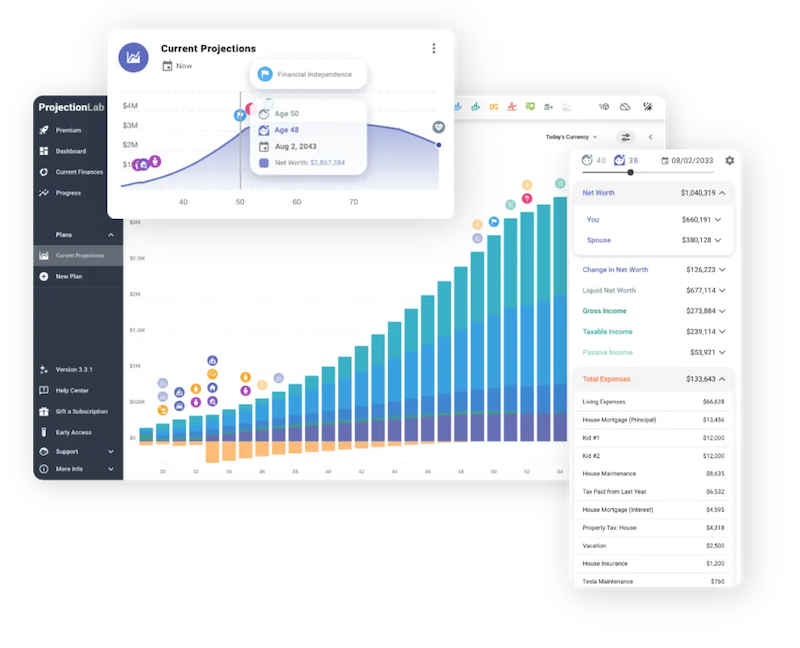
With ProjectionLab, you can create beautiful financial plans with a level of nuance and flexibility that exceeds the standard online retirement calculators. You can run Monte Carlo simulations, backtest on historical data, review detailed analytics for estimated taxes, and plan how to live life on your terms. And with some luck, reduce anxiety around your finances.
There is a free sandbox, if you just want to hop in and see how it works. It does not ask to link your financial accounts. You do not have to create an account to try it, and it works pretty well for international scenarios.
It respects your data and will not try to upsell you on advisory services. It’s just a thing I made that you might like 🙂
Okay, but who am I?
I am a software engineer from Boston. Originally, I grew up in coastal Maine.
I did not expect to one day become a “Masshole” as they are, um, affectionately called back home 😅… but here I am!
And I did turn 30 this year. Ever since I was a kid, I’ve always had a passion for making things. I started coding video games in middle school, and mastered the art of dodging suggestions to “go play baseball instead”. Over the years, I’ve always had a personal project or two on the side.
The way that coding can enable you to take creative ideas and manifest them in the real world will always feel a little like magic to me. And with side projects, it’s refreshing to be free of the constraints that frequently make writing enterprise software a drag. No stand-up meetings, no sprint retrospectives, no changing requirements, and no funding to worry about!
ProjectionLab started as one of these creative outlets. And it has grown into a lot more.
TL;DR. What can you do with this?
Here is a quick summary:
– Build nuanced models of your whole life
– Plan separately or as a couple
– Define what terms like financial independence mean to you
– Model complex decisions based on goals like achieving FI, taking time off for travel, home ownership, or starting a rental empire
– Create multiple plans and compare them
– Visualize projected cash-flow with Sankey diagrams
– Review estimated taxes and effective tax brackets for each kind of income
– Apply granular controls for how you expect accounts/income/expenses/inflation/etc to change over time
– Experiment with Roth Conversions, 72t (SEPP) Distributions, and other advanced strategies
– Model international scenarios
– Backtest on historical data and run Monte Carlo simulations to analyze the spectrum of possible outcomes
– Track your actual progress over time
– Control where your data is saved, with no link to your real financial accounts
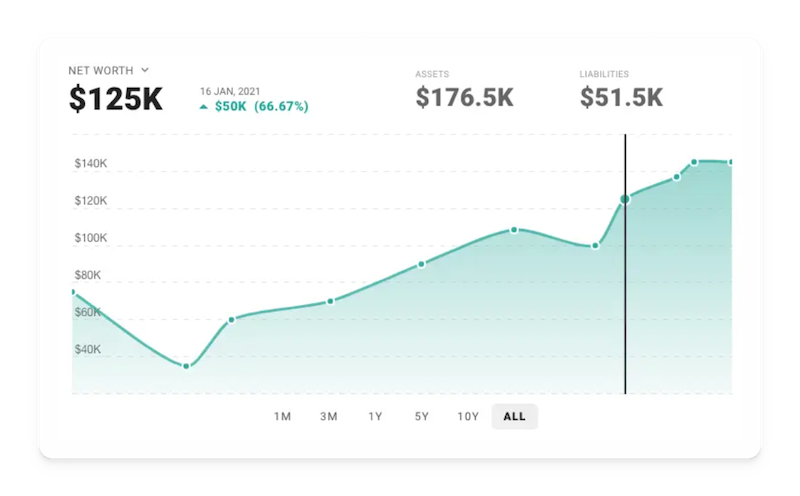
What does FI mean to you?
Think about the future you hope for. What are some of the milestones along the way? One of the first touch points when you create a plan in ProjectionLab is the milestone system. It helps to capture the big-picture goals you care about. And since you’re reading The Mad Fientist, chances are that financial independence is one of them.
But what does FI mean when you break it down? People have different definitions, and I wanted the milestone system to accommodate that. For instance, do you only consider yourself FI at a specific multiple of expenses and a certain liquidity-to-debt ratio? No problem: you can create a milestone with additional criteria.
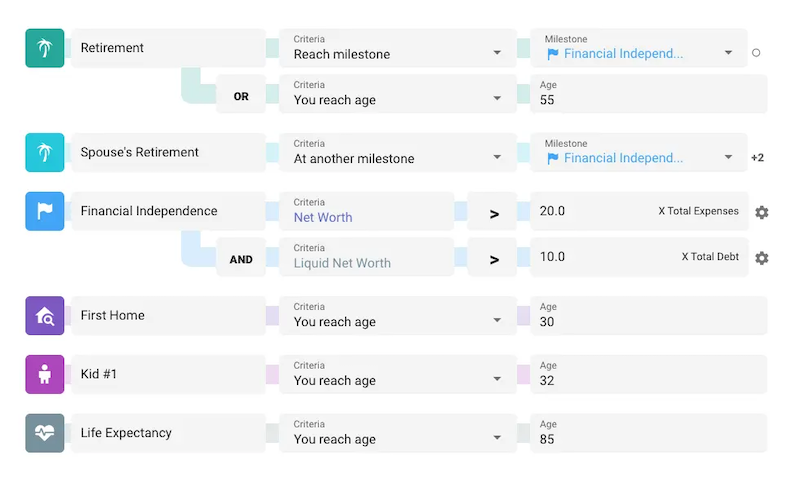
I’ve put some thought into making milestones flexible and customizable. They can be anything from retirement or purchasing a home, to reaching your personal definition of financial independence, having kids, moving to a new state or country, switching careers, going part-time, etc. They can even have tax consequences.
And most importantly: you can use them as a framework to help scaffold the rest of your plan and control when various events should start and end (income streams, expenses, asset purchases, etc.)
Okay. Whatever. Is that just marketing speak, or is this actually useful? How about we build a scenario together and find out!
Let’s build a plan together
Today, we’ll be an early-career married couple with student loans, currently renting, wanting to have kids someday, and we just found out about this thing called “financial independence.”
Let’s see if we can get a sense for where we currently stand, where we are headed, and how to plan a life we’ll love.
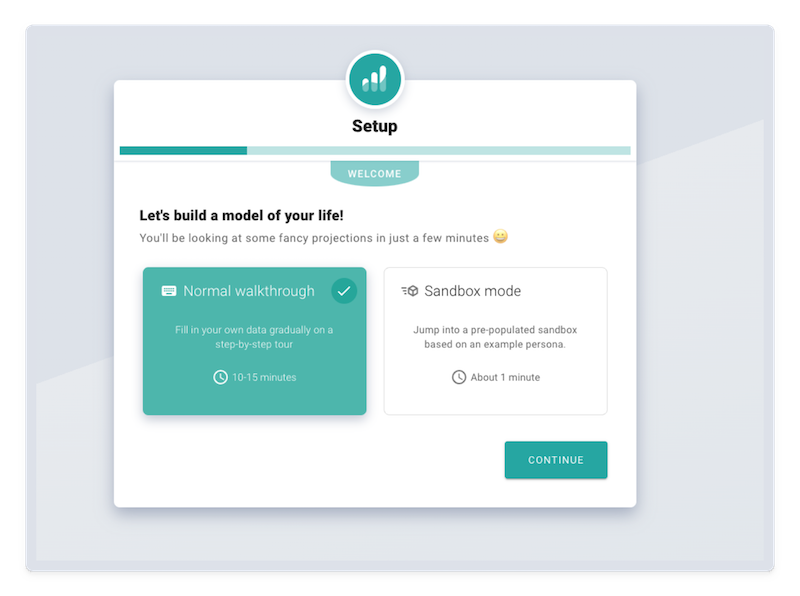
Once we cruise through the setup wizard, here is how things are looking within the Current Finances section. I will also take the liberty to point out that there is a dark mode, if you’re into that 😎
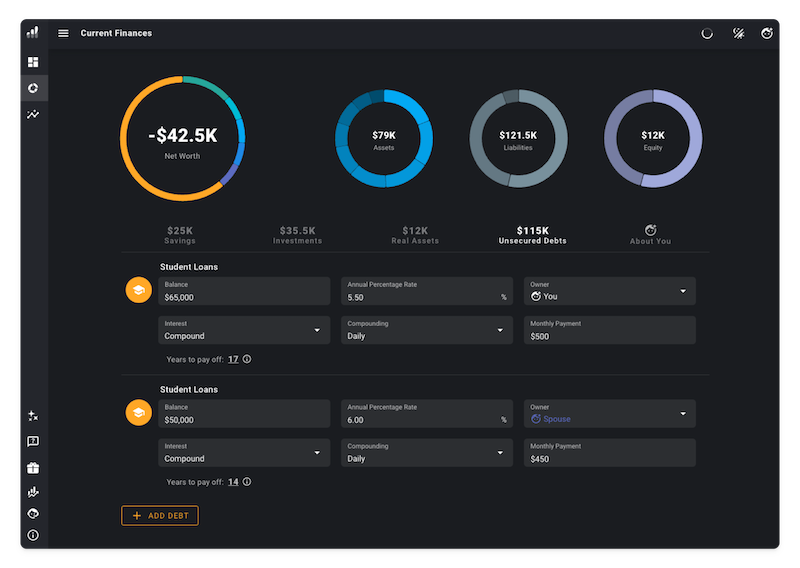
Our current net worth is negative, due to the student loans, but we’re going to get things moving in the right direction soon.
To make projections for the future, let’s create a plan and define growth rate and inflation assumptions for the deterministic planning mode. We will add milestones, income streams, expenses, and cash-flow priorities, choose our tax configuration, set a portfolio-level stock/bond allocation over time, and define a drawdown sequence.
In the interest of time, let’s gloss over that setup process.
The baseline scenario
To keep things approachable, this is what a basic version of our plan might look like.
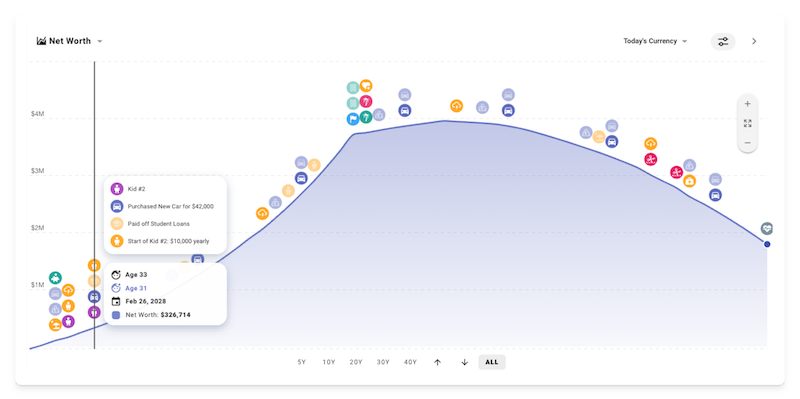
It includes two kids, straightforward career progression, contributions to some employer-sponsored retirement accounts, buying a car every 8 years, medical expenses increasing later in life, and some unexpected emergencies occurring every 15 years (and scaling up a bit each time).
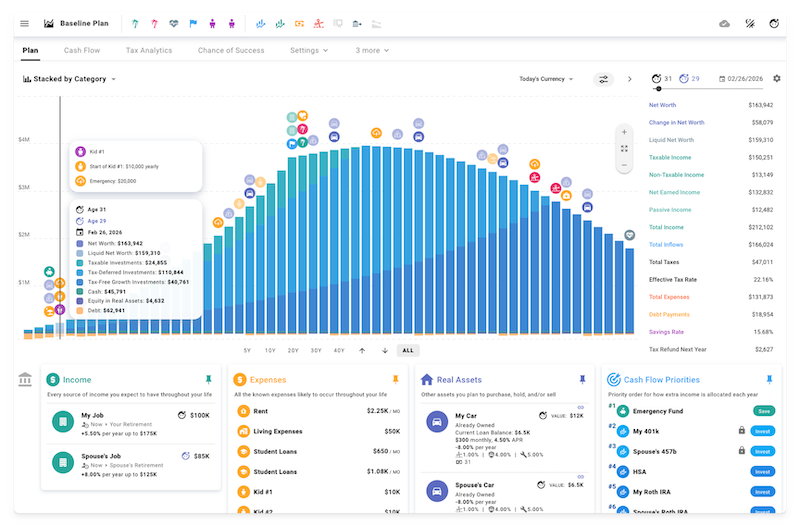
In this case, we will define Financial Independence as a milestone that occurs when net worth reaches 25 times expenses.
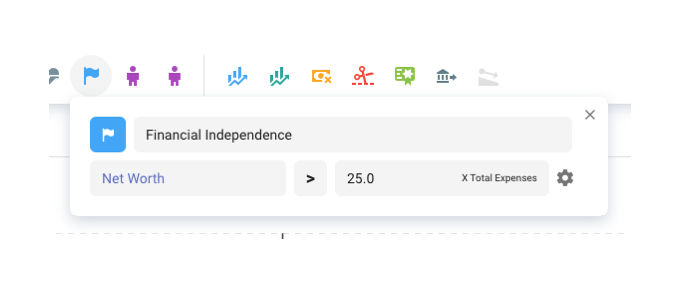
And we will configure retirement to occur once we reach it.
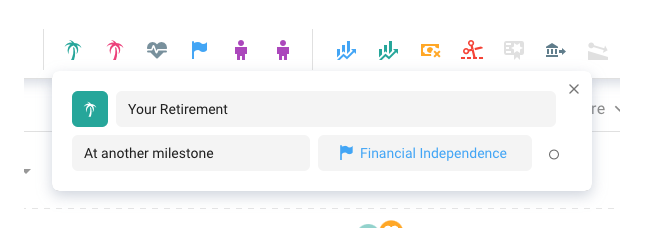
Then, we can use these milestones as bindings when we create other events. For instance, here is a W2 income stream configured to end at the retirement milestone.
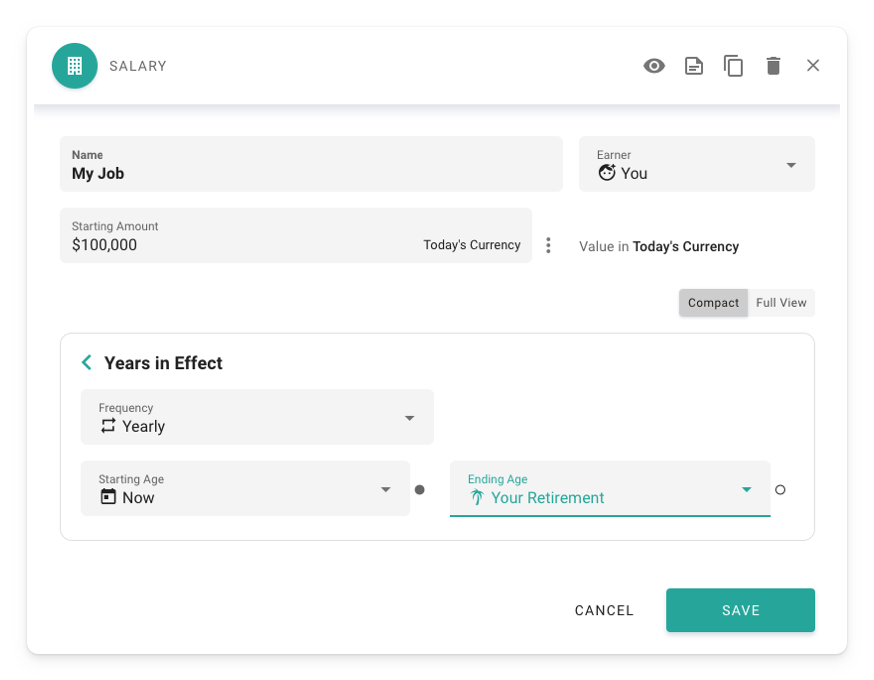
We can also add milestones for the kids, and bind expenses to those. This way, any tweaks we make later to our milestones will propagate to everything else in the plan automatically.
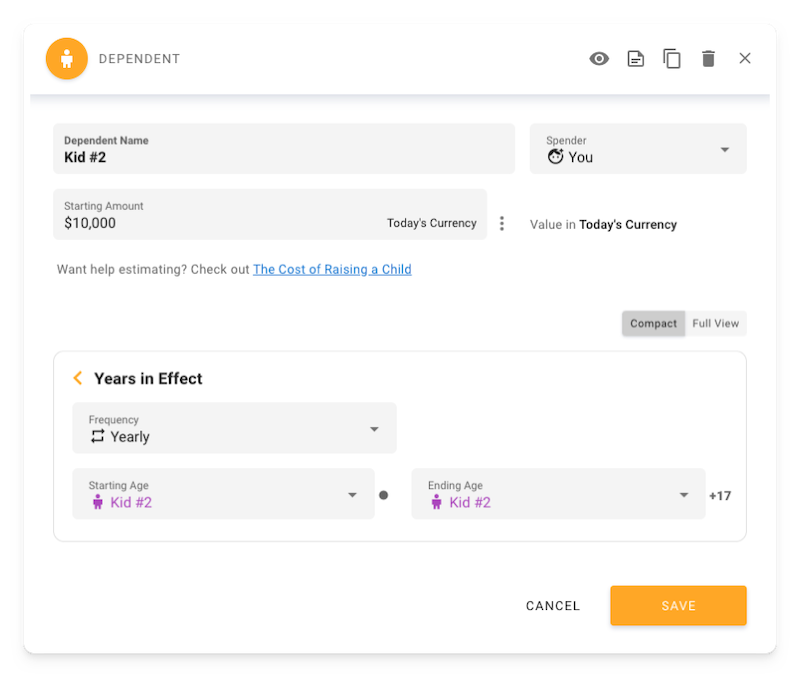
Cash flow visualization
So, what exactly is happening in one of these simulated years? The sankey chart in the cash flow tab can help with that.
We can see how earned income (less withholding) flows into the plan, along with employer match/contributions to tax-advantaged accounts, and how these inflows are used to pay for expenses, service debt, contribute towards investments, and/or build an emergency fund based on our cash flow priorities.
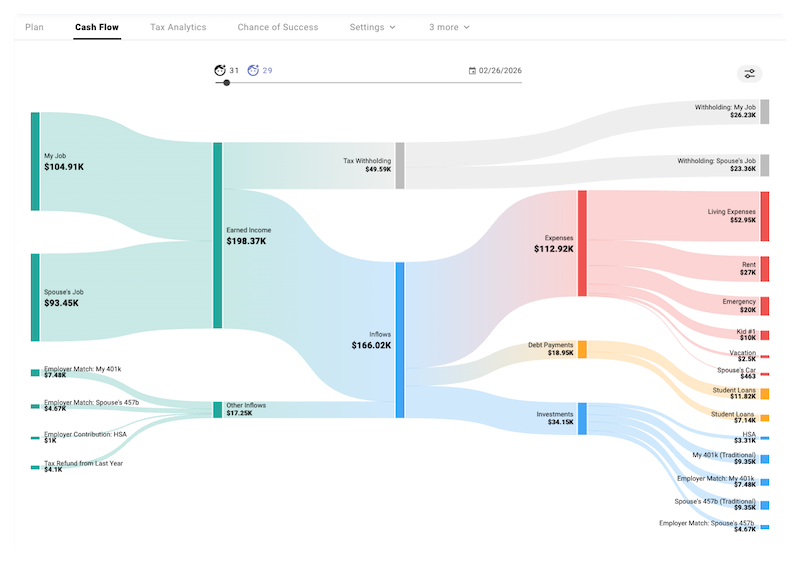
Tax analytics
We can also use the tax analytics module to drill down on specific years and examine how the various kinds of estimated taxes and their underlying brackets apply to each income type.
Within our plan’s tax settings, we’ve enabled US tax estimation:
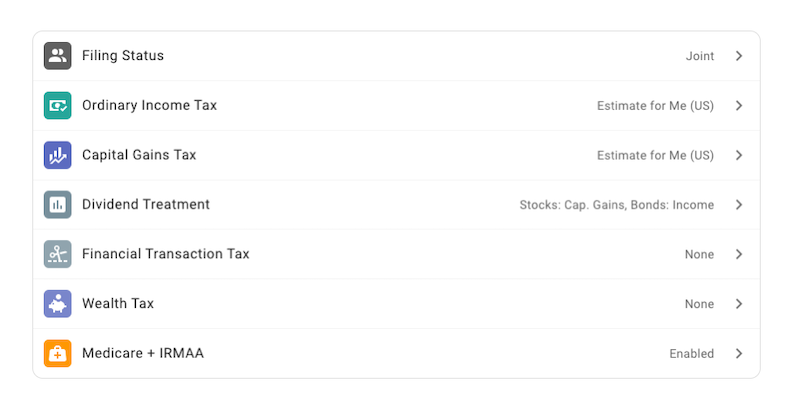
And here’s a look at our projected future income and the effective tax brackets that apply to each type.
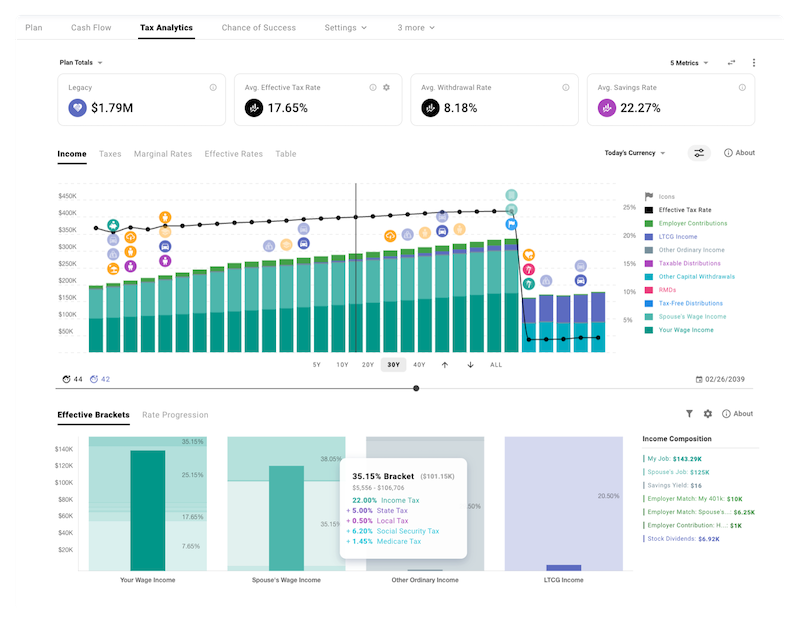
You can plot marginal and effective tax rates over time, and also see how extra hypothetical dollars of each kind would be taxed.
Monte Carlo simulation
But can we expect the market to provide a consistent return every year? Nope. And our plan shouldn’t either.
So far, we have just been playing around in deterministic mode and assuming a consistent 5.34{3df20c542cc6b6b63f1c547f8fb389a9f235bb0504150b9df2ff264aa9a6c16c} real rate of return.
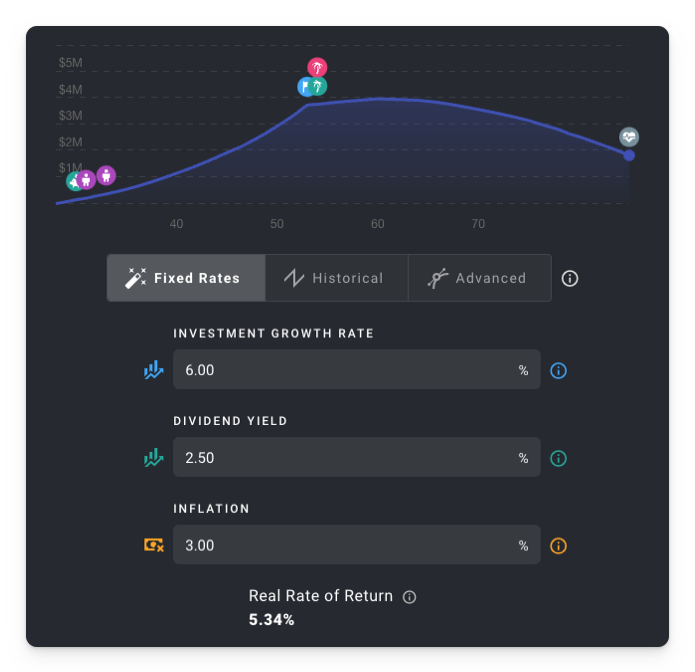
We could choose to explore a specific historical sequence, or create custom return/inflation curves to model a scenario of our own design.
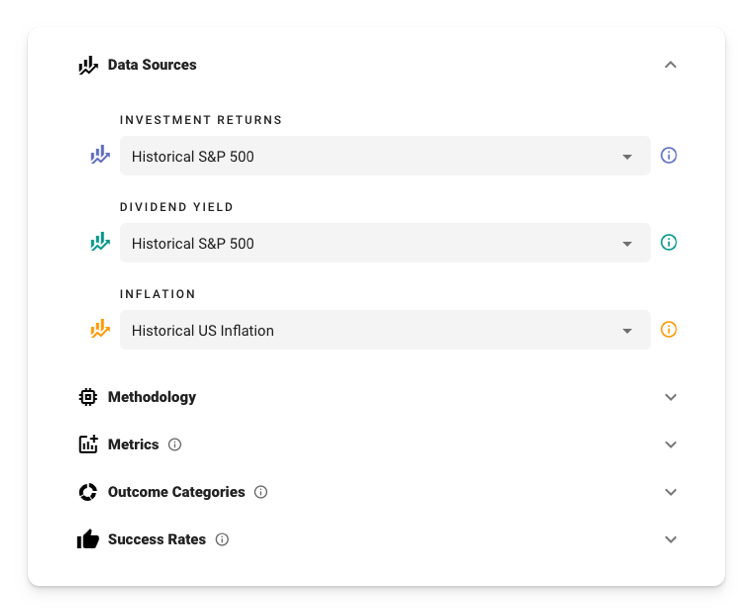
But what if we really want to get a better sense for the full spectrum of possible outcomes? Time to visit the Chance of Success tab and run some Monte Carlo simulations!
Based on 950 trials using historical S&P 500 returns, dividends, and US inflation data, here’s how things are looking so far:
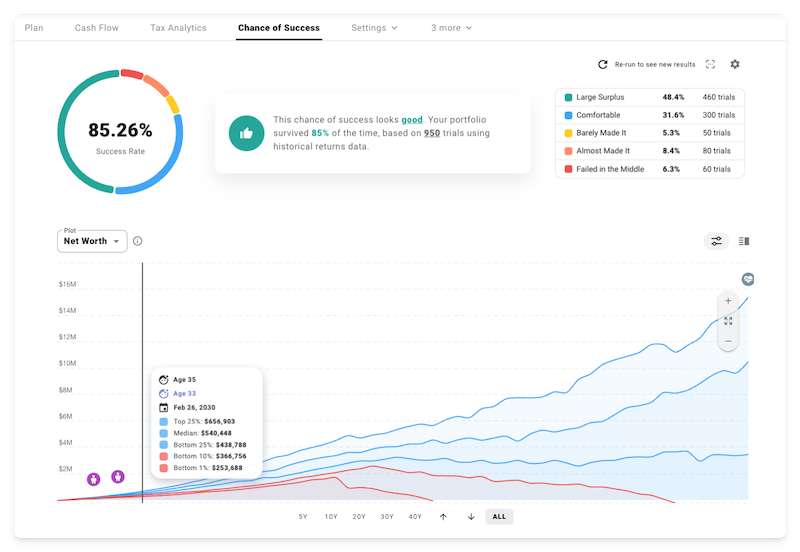
Pretty solid chance of success! And many potential outcomes that actually exceed our future needs by a large margin.
But, is the life we’ve modeled up to this point really the one we want?
Reaching FI in our early to mid 50s after nearly three decades of full-time work is a great accomplishment. But is there any way we could buy our freedom even earlier?
The dream plan
Let’s create a second plan and find some ways to get creative. We’ll start by cloning and renaming the original.
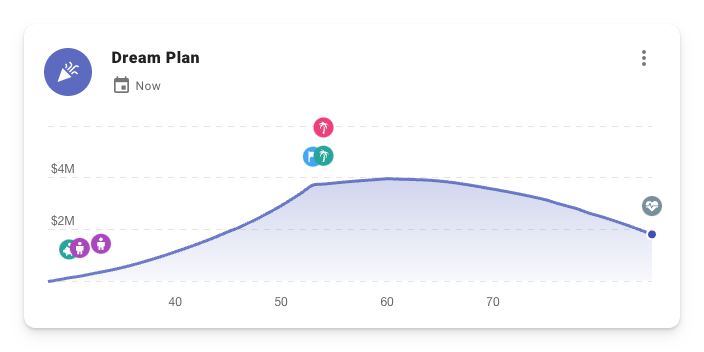
Last time, we allowed some lifestyle inflation to drive up our annual spending over time. Here, let’s keep that under control and build a more granular model for how we think our essential living expenses may evolve.
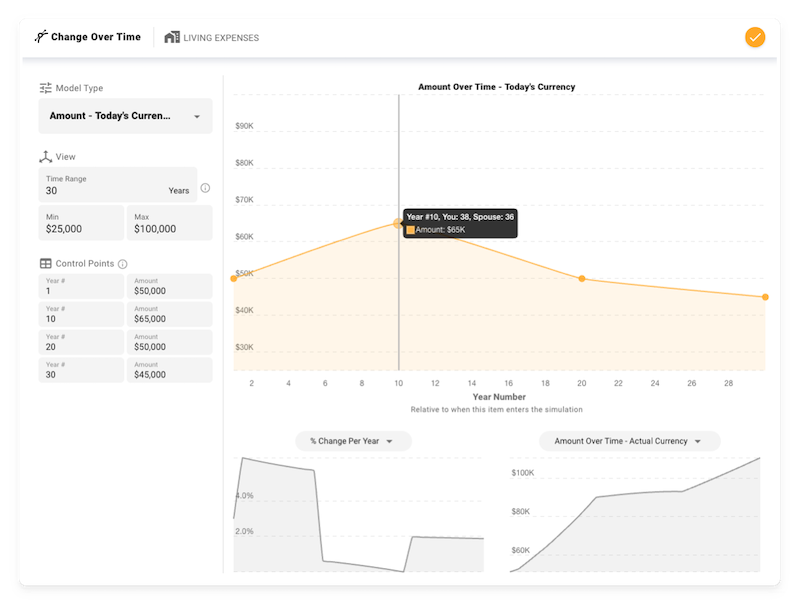
We will also stop renting and buy a house for $500k around the time Kid #1 is born. Then, we’ll drop down to 50{3df20c542cc6b6b63f1c547f8fb389a9f235bb0504150b9df2ff264aa9a6c16c} part-time work at age 40, and we’ll both attempt to fully retire from our W2 jobs at a fixed age of 45.
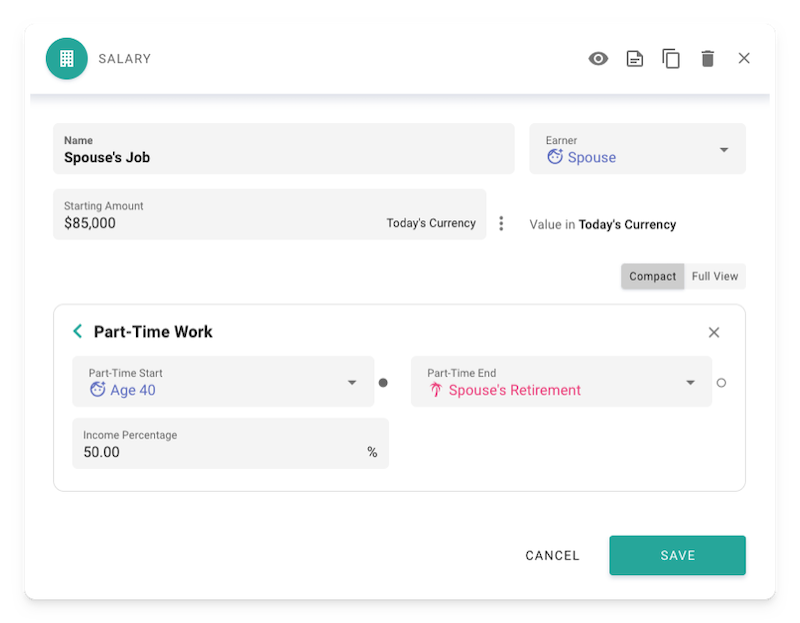
What does all that do to our chance of success? Okay, so version 1 of the Dream Plan is not looking great.
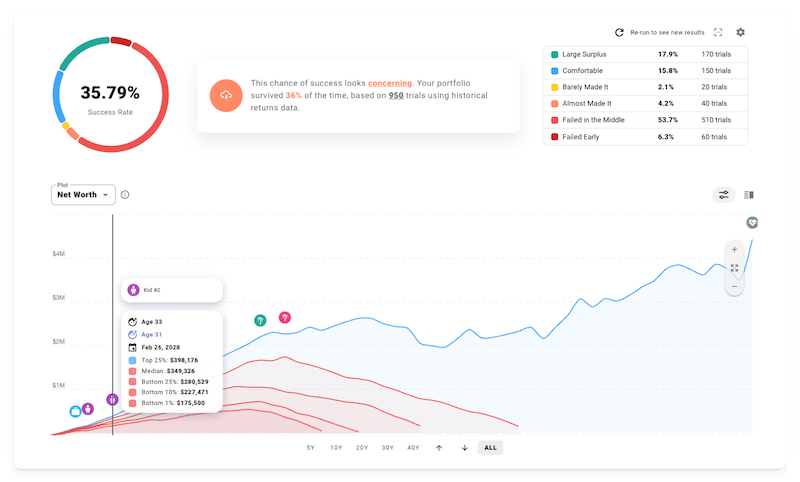
Hmmm.. but what if one of us works hard over the next couple years to land a job paying 25{3df20c542cc6b6b63f1c547f8fb389a9f235bb0504150b9df2ff264aa9a6c16c} more, and we avoid inflating our expenses to match?
That brings us closer to a 50{3df20c542cc6b6b63f1c547f8fb389a9f235bb0504150b9df2ff264aa9a6c16c} success rate.
And what about the extra time we’ll have during part-time work and then early retirement? Maybe we have some hobbies or passion projects we have always wanted to try to grow into a side business?
Let’s model one that starts generating some revenue during that period of part-time work.
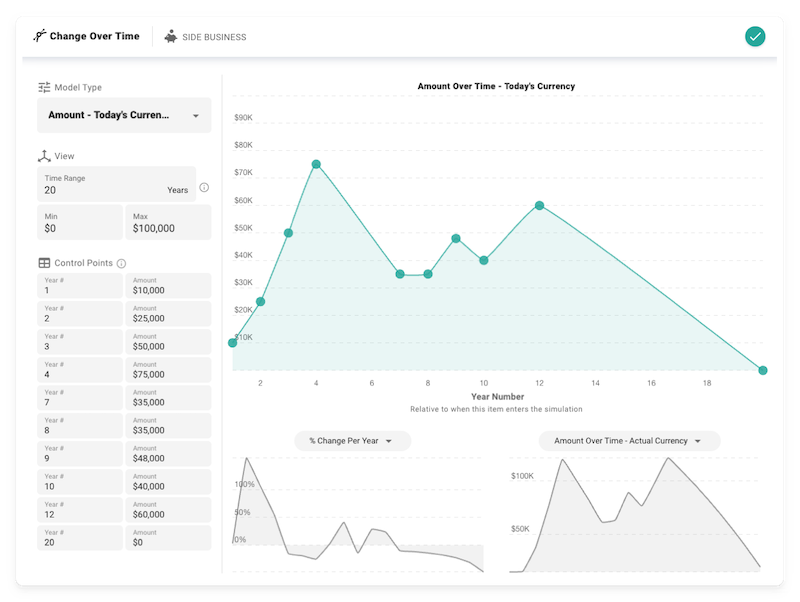
That extra income smooths out those early years after retirement, and brings the success rate back to a more reasonable level near 75{3df20c542cc6b6b63f1c547f8fb389a9f235bb0504150b9df2ff264aa9a6c16c}.
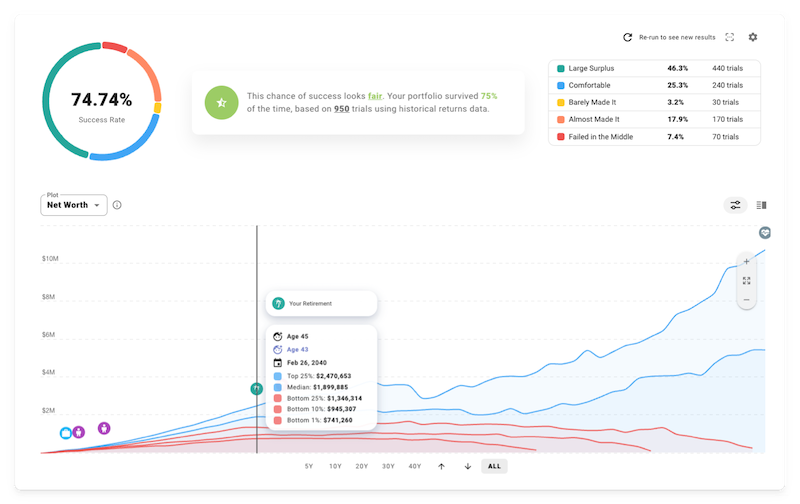
Want to learn more?
At this point, we have just scratched the surface of what you can model in ProjectionLab.
If you feel like taking it for a spin, you may want to dig further into account types and liquidity settings, stock/bond allocation over time, international templates and tax config, patterns of asset purchases + sales, drawdown order, rental properties, progress tracking… Okay, I’ll stop now 😛
Here are a few links with more info:
You can run basic simulations for free with the sandbox version, and you can use this coupon code for 10{3df20c542cc6b6b63f1c547f8fb389a9f235bb0504150b9df2ff264aa9a6c16c} off the premium version: MADFIENTIST-10 🎉
Thanks a lot for sharing, Kyle!
Since I think this is the most-useful (and beautiful) FI planning tool available, I added a permanent link to the sidebar of the FI Laboratory, so that you can easily run projections when you’re updating your FI numbers.
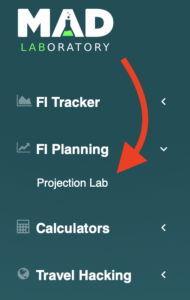
Head over to ProjectionLab now, run a few simulations, and see if you’re as impressed by the software as I am!




:quality(70)/cloudfront-eu-central-1.images.arcpublishing.com/irishtimes/SL4ZJEXTC5DIXNN4OZFLJTU4UE.jpg)

